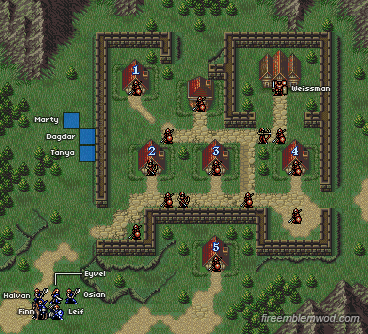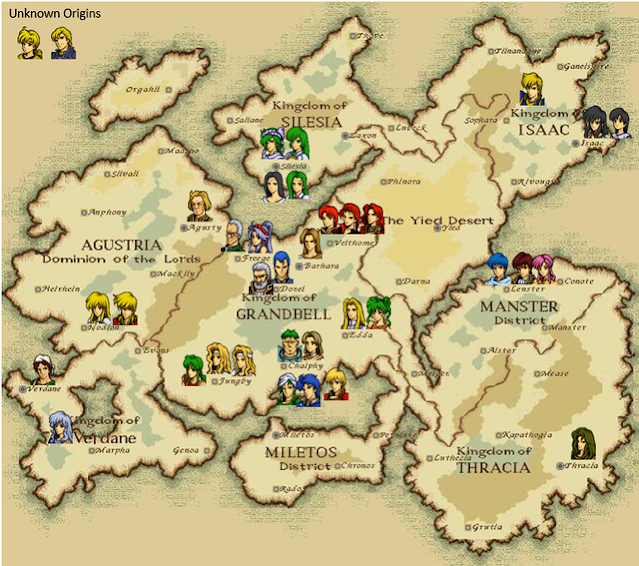Really Good
This tier is reserved for first maps that get lots of things right. The reason why these maps are a whole tier below the top tier is because their turtle disincentives aren't as strong.
Binding Blade
The first map of Binding Blade gives the player 6 characters to use, and there's a brigand that pops up next to the village with the intent to destroy it. It's a weak turtle disincentive, but it still exists so it counts. So it checks both boxes as far as first maps go.
On Hard mode, most of the cast will do menial damage while Marcus carries the team. I am going to deduct points for that, since it's more ideal to have multiple viable characters during the first map. To the game's credit, at least enemy strength is more balanced than in some of the games that have come after.
Thracia 776
Next on the list is Thracia 776. Here, you get a total of 8 characters to use, two houses you can visit that will result in obtaining the Pugi Axe and a Brave Axe, and multiple enemies to fight. Weissman is more difficult than the typical first chapter boss, and while the enemies aren't that difficult to beat, they're still better than the normal axe wielding brigand that frequently show up in a first chapter.
The map gets points for having side objectives, but also loses points for no turtle disincentive. This doesn't hurt the map as much since most first chapters typically don't have them, but it is worth noting.
It's really cool how the game gives you such powerful weapons and characters right off the bat: Eyvel kicks ass in this part of the game, Dagdar's really strong, Finn is super useful (and joins with a Brave Lance. How many games just let you have a Brave Lance from the first chapter?), and you get Orsin with the Pugi.
It's a strong start to an excellently designed game.
Mystery of the Emblem
For a first chapter, Mystery of the Emblem sure knows how to start on the right foot. If you count Mallicia, you start this map with 9 characters. Thieves will appear from the cave to the left and will attempt to destroy the village. On the one hand, this is a turtle disincentive so kudos to the map for that. On the other hand, the thieves are closer to the player than they are to the village, so there's no reason to rush toward the village. It gets some points for the attempt at a turtle disincentive, but then it loses points for how weak it is.
The mountain pass where the brigands are can be a little tedious to get through too. I went back and checked my notes on this map and I said there that only Marth and Arran can move here. That's another net negative for tedious terrain. Still, it's a pretty good map to start a game on.
Above Average: Holy War
Holy War's first map is kind of weird to rate in this particular context. On the one hand, it checks both the boxes off. By the end of the map you wind up with ten different characters in your army:
- Sigurd
- Alec
- Noish
- Arden
- Quan
- Ethlyn
- Finn
- Lex
- Azel
- Midir
But you don't get them all at once. You just start out with Sigurd, your Christmas Cavs, and Arden. Your Lenster squad shows up later and has to play catch up after Sigurd, Alec, and Noish have already started moving. Lex and Azel also show up way the heck out there on the map, away from your main army. So, Holy War's prologue is kind of weird in this respect. Credit given to where credit's due, you still get a bunch of units to use on the first map, and that's always a positive.
As for turtle disincentives, this map introduces the concept that villages don't automatically get destroyed, but instead burn over time. Considering the fact that you lose 500 gold per burn, this works to incentivize the player to move fast.
However, some brigands are so close to the villages that you'll still lose some money even if you go fast. This is something that could have been handled better, but at least some form of turtle disincentives exist. The village by Jungby gives you a Speed Ring, which is really important, so you'll definitely want to save that asap.
Arvis also gives you a Silver Sword, which helps to teach the player that conversations can net the player free stuff.
Two negatives worth mentioning are that Sigurd can obliterate enemies by himself, which puts some pressure off of the player in addition to the Evans army being easy to dismantle by simply blocking the bridge.
On the one hand, Holy War meets both criteria for a first map. On the other hand, it does so in funky ways that hurt the rating. Even with its negatives taken into account, Holy War's first chapter is still leagues better than the maps ranked below it. It fits both criteria, and it manages to teach the player a great deal about the game's mechanics. This is why it merits its own unique rating. It's much more interesting to play than the map where you have few characters in a small map, but it's also not quite as good as the maps ranked above it, hence it's own tier titled "Above Average".







No comments:
Post a Comment